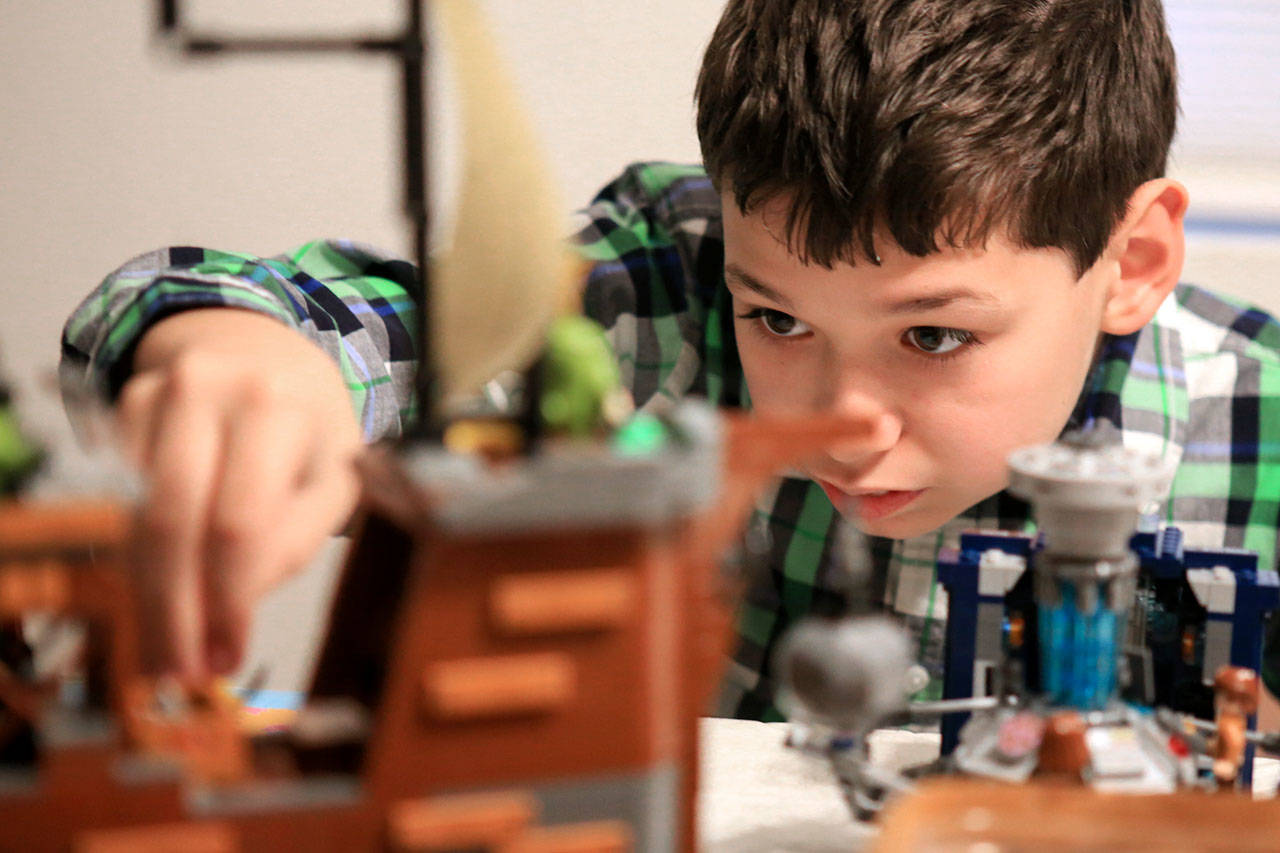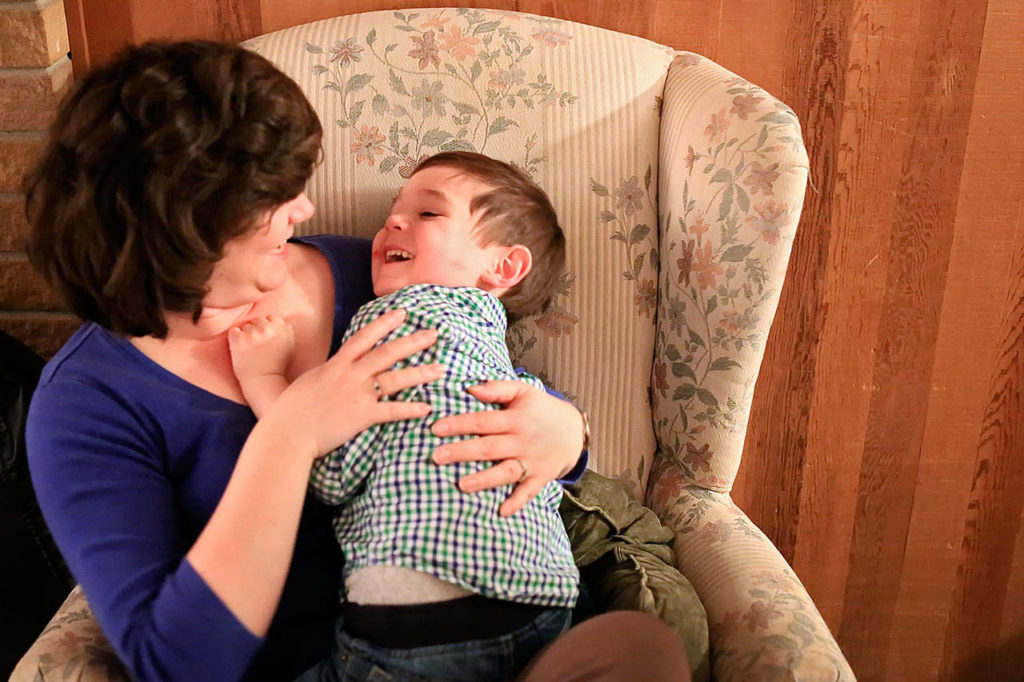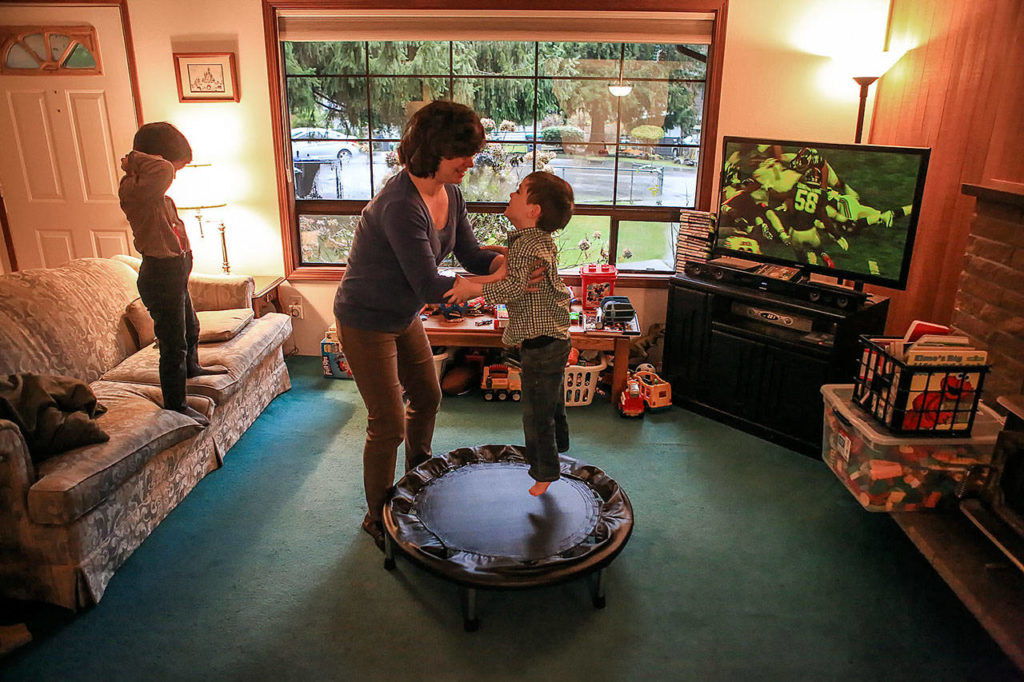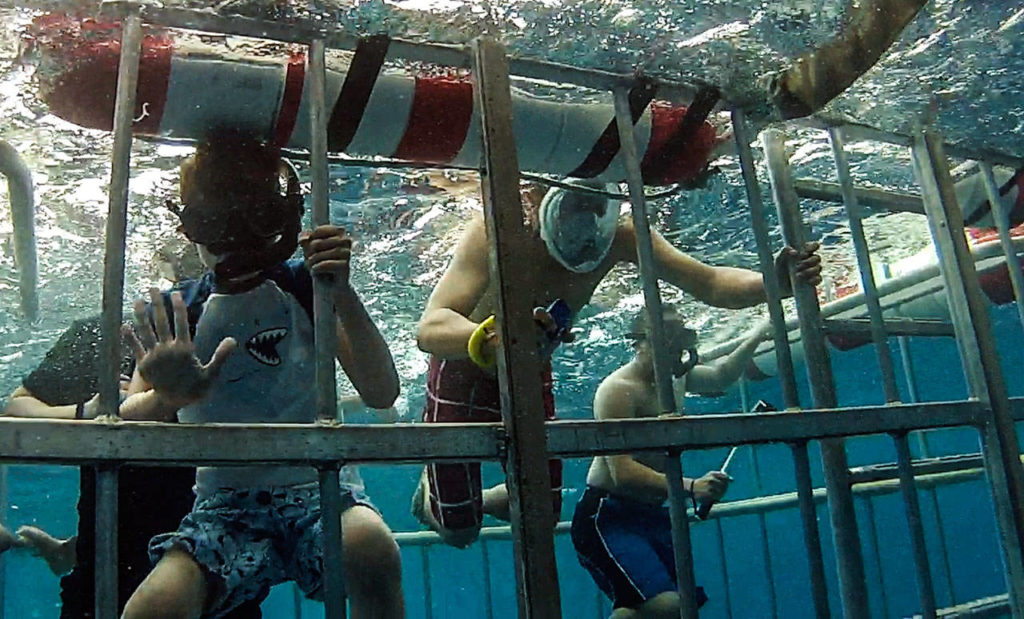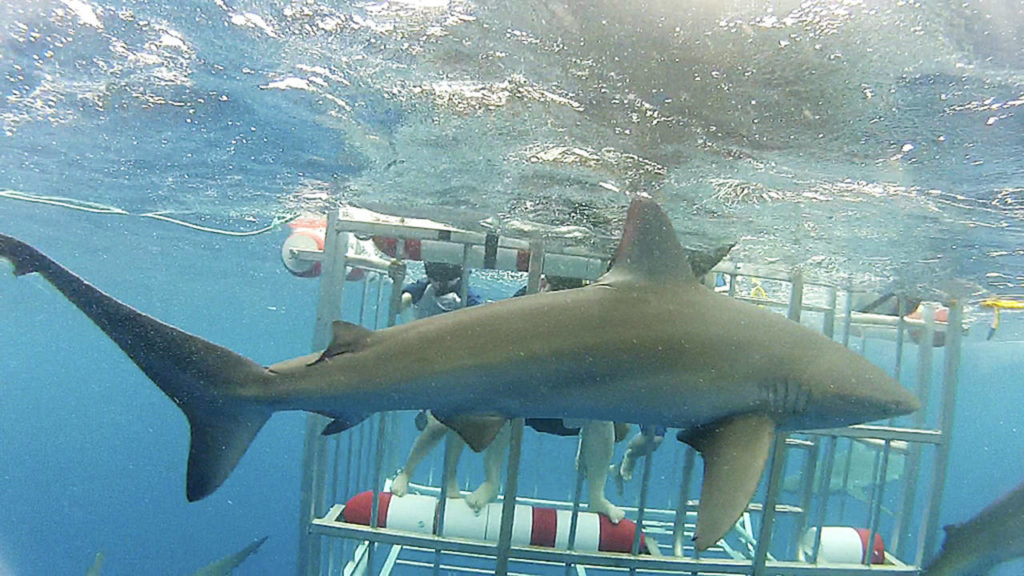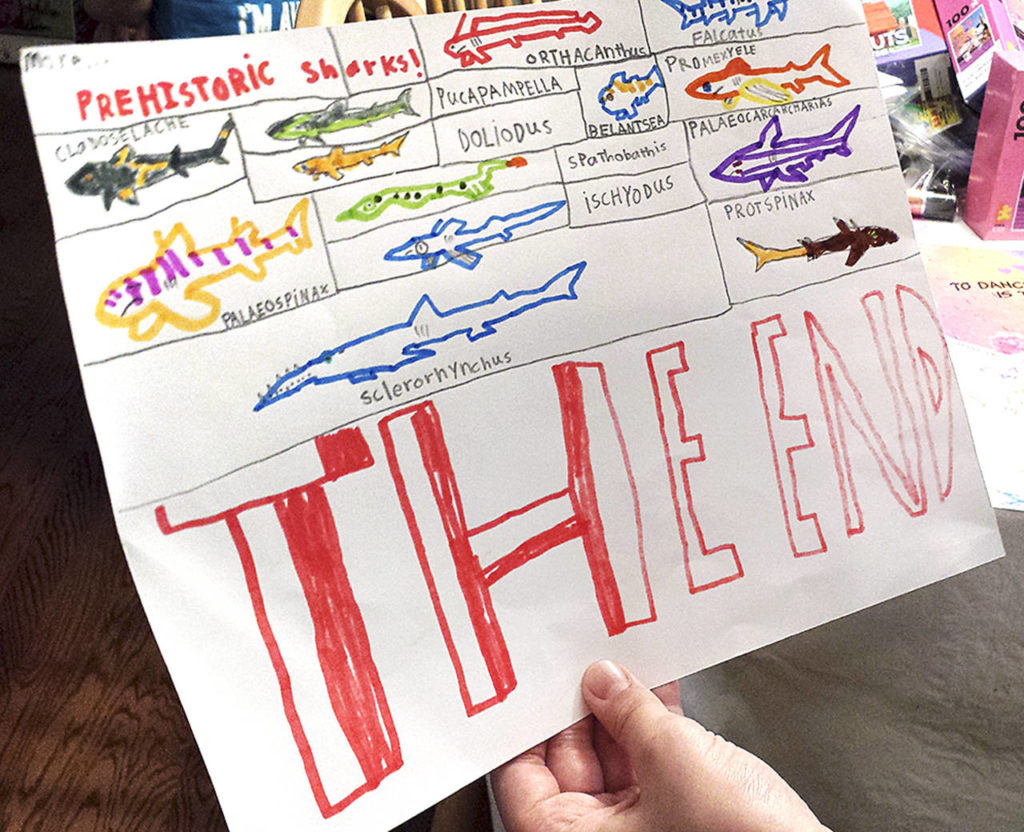BOTHELL — J.T. Fisher was surrounded by sharks.
His delight seemed to flood into his snorkeling mask.
The Bothell boy and his father had boarded a boat that took them to a spot three miles off of Honolulu where they entered a cage and were dropped into the drink.
They were suspended just below the surface.
A photo from an underwater camera last summer shows a 10-foot Galapagos shark just inches from the metal bars, seemingly casting a sidelong glance at the people inside.
Minutes after entering the cage, one woman wanted out.
J.T. was transfixed. It was the highlight of his 11 years of life.
“We knew when we got to Hawaii, we can’t not do this,” his mom, Deanna Fisher, said. “The two great loves of his life are Batman and sharks.”
Yet just getting to Hawaii, or for that matter nearly any family outing, can be its own kind of adventure.
Airport security workers must be alerted that both J.T. and younger brother Colin, 4, are on the autism spectrum. The disorder begins in childhood and affects social interaction, communication and behavior.
Middle son Ian, 7, has attention deficit and hyperactivity disorder.
Their daughter Alexandra, 13, is enrolled in honors classes, but is after all, a teen.
Having special needs kids adds a layer of complications. It requires accommodations that sometimes elicit stares and reactions from others.
When shopping, Colin’s mom brings an iPad to keep him occupied. She pushes a cart and absorbs the judgmental glares. “I could go shopping or deal with a kid,” she said.
Ian once insisted on standing on the seat of a public toilet until his mom, after several unsuccessful requests, finally engaged her don’t-mess-with-me mom’s voice, commanding him, “Sit down!”
A woman who identified herself as a preschool teacher chastised Fisher, saying she needed to be more tolerant.
Fisher has to fasten Colin into a car seat each day to ride the bus to preschool. One morning, an idling motorist, frustrated at having to wait longer than he thought it should take for a young boy to board the bus, yelled a profanity at Fisher.
Another driver berated her older son, J.T., that since he could walk, he didn’t need the smaller bus used for special needs kids.
Her boys seemingly would blend into any crowd. Their disabilities are not obvious at first glance, but the challenges are profound.
Trying to explain to someone who sees and judges from afar just isn’t worth it, she said. Sometimes she wishes she could wear a sign on public outings: “Special needs mom at work. Please don’t interrupt. Help or go away.”
“The Tooth Fairy” study
Scientists have searched for the cause of autism for decades. They have found trends — such as children with older siblings with autism are at significantly higher risk — but have yet to discover its trigger.
Researchers at the University of Washington are part of a national study looking at the baby teeth of the siblings of children who have autism. The Fishers have been enlisted to take part.
Since the teeth are collected from young children, the research quickly earned a nickname, “The Tooth Fairy” study.
Scientists will analyze the teeth looking for signs of exposure to toxins, such as pesticides, flame retardants, chemicals that soften plastics, and heavy metals such as lead, which can affect the development of genes.
A scientific instrument is used to determine when a child was exposed to a contaminant.
It’s similar to doing an ice core study like those conducted in Antarctica, said Dr. Stephen Dager, a researcher and associate director of the UW’s Center on Human Development and Disability.
Volcanic ash and the thickness of layers in the ice core provide information on climate and atmospheric conditions over hundreds of years.
“That’s kind of what we’re trying to do with teeth,” Dager said. The teeth grow out in concentric circles, much like tree rings. They can provide a time stamp if a child was exposed to a contaminant during pregnancy or after birth.
“It’s not as simple as you get exposed to something and have problems,” Dager said. “We’re looking at the interaction of environmental exposure and genes.”
When the tooth study was announced in the fall, Dager was inundated with parents and dentists from around the country who wanted to send him children’s teeth.
Only the teeth of kids who were part of a previous national imaging study looking for unusual brain development — potential early signs of autism — will be accepted.
Some 150 children participated in the UW’s imaging study, part of the 450 infant scans taken nationally.
It will cost about $2,000 to analyze each tooth, work that will be done at the School of Medicine at Mount Sinai in New York and Johns Hopkins University in Maryland.
It will probably be another couple of years before the Fishers’ 7-year-old son, Ian, has lost the five baby teeth needed for the tooth analysis. And several additional years before the teeth from 4-year-old Colin can be donated.
The goal is for the national study to continue for seven years.
“This really is a big question,” Dager said. “Is there something in the environment that could be causing these problems?” It may not be just the exposure, but if someone has the right genetic vulnerability, he said.
The Fishers understand the plight of autism. They want to help others with each tooth they donate.
Infant brain scans can predict autism
It took more than four years before Deanna Fisher heard J.T. say the word she so longed to hear: “Momma!”
His parents had noticed something different in their son’s development when he was 18 months old. “He never learned to talk,” his mom said, far different from daughter Alexandra’s development.
J.T. was diagnosed with autism just before his fifth birthday. He began weekly sessions at the UW’s Autism Center to help him develop speech and other skills — work which has continued for the past six years.
At J.T.’s first session, Fisher saw flyers announcing an autism study. Researchers were seeking children for infant brain imaging research. They needed kids who were about 6 months old who had a sibling diagnosed with autism.
At the time, Ian was 5 months old and joined the study. When Ian turned 3, the family’s third son, Colin, was born. Fisher enrolled him in the testing program, too.
“The question was what happened that made some kids go on to develop autism?” said Dager, the UW researcher.
They found differences in children’s brains at between six and 12 months, a sort of early warning signal on the potential for developing autism.
“It’s the surface contours and surface area of the brain and how the parts of the brain connect to each other,” Dager said.
Researchers working on the national effort found the tests could accurately predict 80 percent of infants who would be diagnosed with autism at 24 months of age, according to a recently published report in the journal Nature.
The study “helped us flag our youngest at age 1 that he was exhibiting signs of autism,” Fisher said. It enabled Colin to get early intervention and therapy.
“Research has helped us,” she said. “It’s given us the opportunity to jump in earlier than a lot of families have had the opportunity to do.”
“I want music, please”
Strangers just seem naturally drawn to Colin, attracted by his boyishly handsome face, gentle smile, and eyelashes so long they would make a movie star envious. But they’re often startled by his reaction when they greet him.
“He won’t respond to them,” his mom said. “He can’t say his name is Colin and he’s 4.”
Over the past year, he’s begun to say simple sentences. His most frequent request is: “I want music, please.”
He prefers orchestral renditions of film scores, especially those of John Williams, played during the end credits of movies.
He’s learned colors by matching the appropriate word with brightly colored M&Ms. UW therapists are helping him identify animals, solve puzzles and follow directions.
The out-of-pocket costs for the boys’ therapy sessions at the UW and other private speech therapy sessions total $1,100 a month, more than $13,000 a year.
Brother J.T. has a natural, outgoing friendliness, unafraid to walk up to adults he’s never met. He often greets them with a question: “Have you heard of the Lego Batman movie?”
He takes weekly arts classes in Bothell, using acrylics for a painting of moonlight on water. The instructor recently asked him to demonstrate his skill in drawing sharks.
His parents are working to help him understand the passage of time: last year, last month, last week, today.
Alexandra, J.T’s sister, is in the seventh grade. She remembers that as a toddler her brother loved being held, preferred playing alone in his own little world, and had very few words.
She was nearly 7 when her mom told her that her brother had autism.
“I did understand he was just a lot different than most kids his age and his life was going to be a lot different than normal kids,” she said.
J.T. had planned to join other Northshore School District fifth graders earlier this month at a three-day, two-night camp near Lake Stevens.
As the departure date drew closer, J.T., who does best with familiar schedules and routines, began telling his mom all the reasons why he shouldn’t go. He was sure bears, or alligators, or tigers, or bats would show up at the camp.
His mom told him he’d be living it up, with cabins to sleep in and a chef to prepare their meals.
He was protesting until the day they left, said Eric Fisher, J.T’s dad, who went with his son to the camp.
It didn’t take long for his son’s attitude to change.
Soon he was trying his hand at archery. He had never used a bow and arrow, but was convinced all six of his first shots would hit the bull’s-eye.
The first three arrows went straight into the ground. His final three shots hit the target, but weren’t bull’s-eyes.
J.T.’s disappointment quickly boiled over.
His father tried to calm him with praise. J.T. wasn’t having it. He wanted to go home.
In the end, the most unexpected moment of the day wasn’t J.T’s sudden anger and frustration on the archery range.
It happened that evening, a big moment of insight. His son turned to him and said, “I’m sorry, Dad, that I got grumpy with you.”
“Grace to accept him”
J.T. will start middle school in the fall, a transition inherent with worries for the parents of special needs kids.
Who will help him with the combination for his school locker, or guide him from class to class, or keep an eye on him at lunchtime — the place kids seem the most apt to taunt?
At first glance, his lanky body seems to fit the profile of any other soon-to-be-teen boy. But his emotions lag behind his age, sometimes spilling out tears and frustration with an intensity of a young child.
Deanna and Eric have been married for 16 years. Deanna decided to be a stay-at-home mom after the birth of their first child.
Eric works in Bothell as a development operations engineer for EagleView, which produces structural reports for roofs using high definition imagery.
Date night is a once a week — at home — viewing of the TV show, “Speechless,” a sitcom whose main character has cerebral palsy and is non-verbal and in a wheelchair.
Deanna and Eric teach a special needs Sunday School class at Evergreen Church in Bothell. Family life is filled with swim lessons, cheering daughter Alexandra in 5-K runs, weekly trips for J.T’s and Colin’s appointments at the UW’s autism center and weekly speech therapy for both boys.
Joy in the chaos
On Halloween, the family dressed in a Dr. Who theme. Deanna joyfully admits “we’re nerds.”
In January, the family attended the Mariners’ pre-season FanFest at Safeco Field. The three older kids played catch on the field with their dad.
J.T., who once was overwhelmed by the noise and crowds at stadiums, has learned to adjust, while Colin loved the stadium’s wide open spaces and big screen.
The developmental challenges of their kids, which can fuel public tantrums, are often mistaken as simply out-of-control kids.
“Describing our lives is a window into a different world,” Deanna said. If people could see how much work goes into just being out in public, “maybe it would help them understand the times when things don’t go well.”
As J.T. grows older, the Fishers wonder what his future holds. Will he live with them or a guardian? Can he find a job?
“If he had any job involving sharks, even swabbing the deck of a boat, it would be his absolute dream,” she said.
Her fondest hope for her son goes beyond jobs and whatever level of independence he’s able to achieve. It’s simply that people “have enough grace to accept him as he is.”
Sharon Salyer: 425-339-3486 or salyer@heraldnet.com.
No single autism cause likely exists, UW center director says
SEATTLE — There’s a reason scientists have searched for years trying to unlock the mystery of what causes autism.
The problem is there likely will be no one single answer, said Annette Estes, director of the University of Washington Autism Center.
“It would be a lot easier to communicate if it was one cause,” she said.
Technology has allowed scientists to find some small and some large genetic changes that lead to autism.
“Unfortunately each of those types of genetic causes tends to affect a small group of people,” Estes said. “There’s not a silver bullet.”
Researchers at the UW and elsewhere are now exploring how these genetic factors may interact with environmental pollutants to affect children’s development.
If certain brain systems are affected, it can result in problems with children’s ability to communicate and learn, Estes said.
The search for autism’s cause has led some, including Robert Kennedy Jr., to blame the developmental disorder on vaccines — a theory which has been widely investigated by many independent groups. “There is no link there,” Estes said.
Nevertheless, President Donald Trump appointed Kennedy to lead a commission on vaccine safety.
The Autism Center, now in its 17th year, provides services to about 600 patients annually. Eighty percent are children.
It is part of the university’s Center on Human Development and Disability, which brings together research and clinical services. It is one of 15 designated Eunice Kennedy Shriver Intellectual & Developmental Disabilities Research Centers, based at universities and children’s hospitals around the nation.
The Autism Center has used a variety of approaches in its research, including having parents take video of their children. Specialists can see how parents are applying techniques learned at the autism center “and which interventions work best for kids,” Estes said.
—Sharon Salyer
Talk to us
> Give us your news tips.
> Send us a letter to the editor.
> More Herald contact information.
